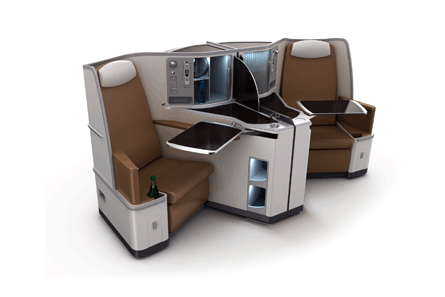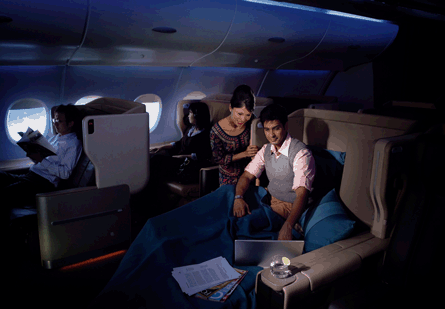Imagine you are seated in economy class on an ultra-long-haul flight. When you are free to roam, where do you go? Your options are limited. You can walk up and down the aisle or go to the lavatory. But if airlines offered the type of luxuries now seen in some premium cabins, such as a stocked bar, these passengers would "spend more on that flight, I'm sure", says Ceri Rocca, one of the UK's foremost designers for transport interiors.
As airlines struggle to fill seating capacity in today's painfully difficult economic climate, novel cabin concepts that offer the allure of brand differentiation or the possibility of ancillary revenue generation - or both, as in the case of a cash bar in economy class - are sure to spark conversation at the Aircraft Interiors Expo on 31 March-2 April in Hamburg.
Designers able to show a more efficient use of materials and a better exploitation of cabin space may find themselves in hot demand at the event, which is organised by Flight International sister company Reed Exhibitions.
 |
|---|
© James Park Associates |
"There has been talk about cash bars for economy. Whether that continues, with the economic climate, and whether airlines lay out more space for that sort of thing, is not clear," says Rocca, who works in partnership with design consultancy Design Q.
"However, having said that, one of the things that airlines are struggling with is filling the capacity of their seats. So it could be worthwhile having an area like that. They wouldn't be losing money because the seats aren't selling. And they would have more of an edge to sell the other economy seats."
People want to feel like human beings. "In economy, you sometimes feel you're being treated like a steer," suggests one frequent business traveller. Taking the "cattle-class" sensibility out of coach, Australian operator V Australia lays claim to the Pacific's widest seats for economy travellers. A self-service kiosk keeps peckish passengers satiated.
The carrier's premium economy offering goes a significant step further, however. Passengers can swing by the self-service bar for a drink or two on the house as soon as cruising altitude is reached.
V Australia is just one example of how out-of-the-box thinking is alive and well. "It may be too early to judge the impact of the latest economic problems. Airlines began feeling the pinch years ago and took steps to survive. That resulted in a slowdown of cabin upgrades, and better planning of those major programmes. This slowdown will likely continue," says Ford Chown, consultant and engineer for Linford Aerospace
"However, commercial aviation has progressed from an 'adventure' into a stable business, and the cabin environment is part of the marketing package for that business to compete in the industry," he adds.
Carriers that regularly get it right are familiar names such as Airbus A380 launch customers Emirates and Singapore Airlines.
"The interior cabins make flying a beautiful experience. I think it encourages people to fly our airline. It may even encourage them to fly more often," says Emirates vice-president for passenger communications Patrick Brannelly.
 |
|---|
© James Park Associates |
Other carriers are making their mark. "Travel agents say they are hearing roars of applause for the new seat in the international economy-class cabin of the A380 operated by Qantas, the third launch customer," says author and consultant Jennifer Coutts Clay.
At the top of the seat there is a movable winged head-and neck-rest cushion; and when you recline your seat-back panel, the seat-base sitting area moves forward by a couple of inches. "This type of mechanism is frequently used for seats at theatres, cinemas and sports stadiums because it provides an added amount of personal comfort without encroaching on the space of the people in the row behind you," says Coutts Clay.
FOOTREST NETS
The Qantas long-haul economy-class experience is further enhanced by the addition of footrest nets under the seats of the row in front of the passenger. "When stretching out, passengers can get their feet off the floor and supported in a comfortably flexible cradle. This ingenious innovation is much simpler to use than the traditional front-or rear-projecting foot bars - the nets stop passengers from sliding forward when they are sleeping. And it is virtually weightless," says Coutts Clay.
Yet, as with long-term fleet replacement, it will be difficult for marginal airlines - those unable to control costs or generate profits - to raise the necessary funding to support expensive interior upgrade programmes, she says.
Design Q's Rocca says most carriers are looking at weight reduction in economy. "That seems to be the main concern, not making it any more fabulous an experience for the customer. It's more about, 'how can we save ourselves a little bit of money with it'."
Therefore, less radical choices could attract the most cost-conscious among airlines. For example, the concept of "slim seats" is gaining in popularity. "We've been promoting this for a very long time," says designer James Park of James Park Associates (JPA). "We, too, are developing a very lightweight, economy-class seating solution, which does provide more space, less weight, fewer parts and a lower cost of ownership. It's logical, isn't it?"
However, he is encouraged that airframers are reportedly considering stacked sleeper seats for long-haul, economy-class travel. "I'd like to think that companies like Airbus and Boeing would examine something like that. We've applied our minds to this and produced concepts. It would be exciting if somebody did initiate production of something like that and I'm sure the problems could be solved. The real question is the level of commitment required to make a success of such an undertaking."
The most impressive innovations are at the front of the cabin. Lie-flat beds in first class have increasingly become the cost of doing business. "Whether that will change, if the economic situation gets worse, I don't know. However, increasingly that seems to be the standard for all flights from 8h upwards," says Park.
"We've reached a point where semi-lie flat seats are not acceptable, but semi-lie flat did allow the seats to be all forward facing. Airlines could provide a two-four-two layout and that would give a good passenger count. It's better than sitting upright all night, and perhaps could still be exploited if the sleeping platform could have a more sophisticated design."
The great buzz is about the new-style first-class suites that provide standards of luxury and privacy unparalleled in the history of aviation, says Coutts Clay, noting that SIA generated a huge amount of publicity around its new first-class product, described as "your very own office, dining room and bedroom in the sky, in the privacy of your inner sanctum".
Two years ago, Swiss International Air Lines set about to develop a clean and simple first-class product that would have "more of an architectural" design and fall in line with the same design language of its brand. When Swiss begins operating its new Airbus A330-300s in April, first-class passengers will be able to invite a guest for dinner as each passenger has an ottoman and a large dining/working table offering enough space for two. Individually adjustable sidewalls for privacy can be closed while sleeping or working.
Lie-flat seats allow each Swiss first-class customer to choose the softness or firmness of the seat cushion and backrest. And each passenger can enjoy the latest in in-flight entertainment on 23in (58cm) screens.
 |
|---|
© Swiss |
"Our product drive is primarily intended to further strengthen our position as a top-quality airline. And the investments we have made in the past suggest that this is the best way to do so," says Paul Estoppey, senior manager and head of cabin interior development and infotainment for Swiss.
What types of innovation can passengers expect in the future? "I think that in the context of the current economic climate there may be opportunities now to start looking at new ways to making air travel more economical, while at the same time maintaining very high levels of comfort," says Park.
"This is obviously a design challenge, but it is a challenge that JPA would welcome. We will be launching a product at Hamburg, the Cirrus seat, that helps achieve just that."
Chown predicts improvement in technology for passenger electronics using satellites (in-flight entertainment, connectivity, telephony); in air quality; in window shade capability, such as light diffusion plus blackout capability; and in fault identification systems for quick maintenance and better maintainability.
'GREEN' EMPHASIS
Coutts Clay also sees an emphasis on "green" aviation, including the use of water filters and sustainable products such as wool and other natural fibres; the use of lighter accessories such as oxygen containers, galley carts, crockery and cutlery; development of hi-tech waste-management programmes to handle in-flight products; smarter on-board baggage stowage options; and new-style lighting techniques that can provide the impression of on-demand full-cabin interior decor changes at the flick of a switch.
Estoppey points out that consolidating one's position as a top-quality airline is a long-term undertaking, something Swiss considered when developing its new in-flight product. "We should also bear in mind that, while the economy is not strong, air transport remains a growth sector in the long term. So by making these investments now, we are equipping ourselves to take full advantage of the next economic upturn."
Source: Flight International
















